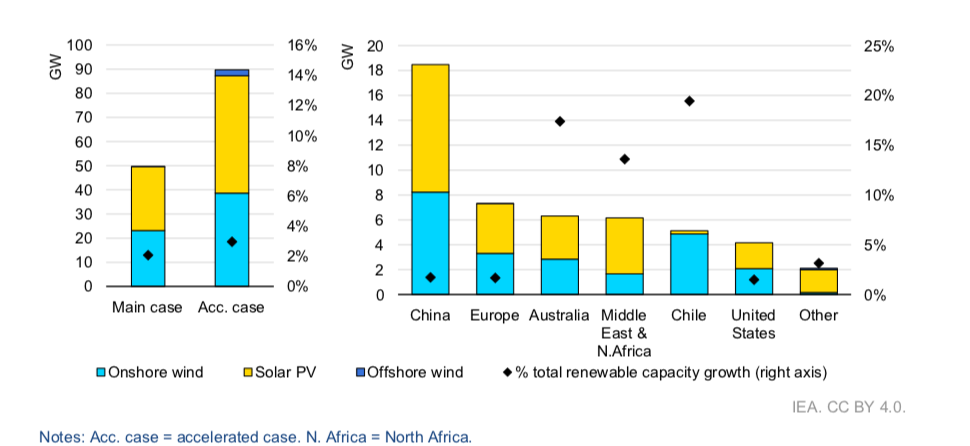The International Energy Agency (IEA) said in a new report that the amount of global renewables capacity dedicated to producing hydrogen will increase 100-fold over the next five years. “For 2022-27, the main case forecasts around 50 GW of renewable capacity to be dedicated to hydrogen production, accounting for 2% of total renewable capacity growth,” it said in a newly published report. “China leads expansion, followed by Australia, Chile, and the United States.” It added that these four markets account for two-thirds of dedicated renewable capacity for hydrogen production. New capacity is split evenly between PV and onshore wind, with PV making up most of the growth in the Middle East and North Africa region. China is set to deploy more than 18 GW of dedicated renewables capacity by 2027, while Europe will add 7 GW. “Spain is in the lead, accounting for half of Europe’s growth, followed by Germany, Sweden, Denmark, and the Netherlands,” said the IEA, noting that regulatory and policy uncertainty are the two obstacles to for European hydrogen development.
The Netherlands is on track to potentially exceed its ambition of 500 MW of domestic electrolysis capacity by 2025, said Energy Minister Rob Jetten in a letter to the Dutch parliament. “In the coming year, the government expects about 1 GW of electrolysis capacity to be subsidized, after which investment decisions are expected in the short term,” he wrote. Jetten said he expects subsidies for 800 MW to 1,000 MW of electrolysis capacity through the Important Project of Common European Interest. The final selection of the electrolysis projects presented in September 2022 for the first round, with a budget of €783.5 million ($822,40 million). The final aim is to reach 20 GW of hydrogen capacity by 2030.
Ørsted and Skovgaard Energy have signed a letter of intent to jointly develop a multi-phase Power-to-X facility in Idomlund, western Denmark. “The first phase of the project will have an expected electrolysis capacity of 150 MW and will be powered by onshore wind and solar PV,” said Ørsted. The electrolysis capacity could eventually increase to more than 3 GW, said the two companies.
Jacques Delors Centre has published an interactive chart showing the cost of importing hydrogen to Europe via several routes. The tool considers gaseous pipelines, H2 liquefaction, and ammonia conversion as possible transportation options.
Popular content
Embraer has revealed two new decarbonized aircraft concepts, including Energia H2 Fuel Cell, a 19-seater with hydrogen-electric propulsion. It said that the relative technology should be ready in 2035.
Hyliko has chosen Forsee Power as its partner to equip its first hydrogen-powered heavy-duty vehicles with the PULSE 2.5 intelligent battery system, said France’s first hydrogen mobility platform dedicated to decarbonizing road freight transport.
Alstom and Air Products have signed a memorandum of understanding to deploy hydrogen solutions in rail, including the necessary infrastructure in the Czech Republic.
This content is protected by copyright and may not be reused. If you want to cooperate with us and would like to reuse some of our content, please contact: editors@pv-magazine.com.


3 comments
By submitting this form you agree to pv magazine using your data for the purposes of publishing your comment.
Your personal data will only be disclosed or otherwise transmitted to third parties for the purposes of spam filtering or if this is necessary for technical maintenance of the website. Any other transfer to third parties will not take place unless this is justified on the basis of applicable data protection regulations or if pv magazine is legally obliged to do so.
You may revoke this consent at any time with effect for the future, in which case your personal data will be deleted immediately. Otherwise, your data will be deleted if pv magazine has processed your request or the purpose of data storage is fulfilled.
Further information on data privacy can be found in our Data Protection Policy.